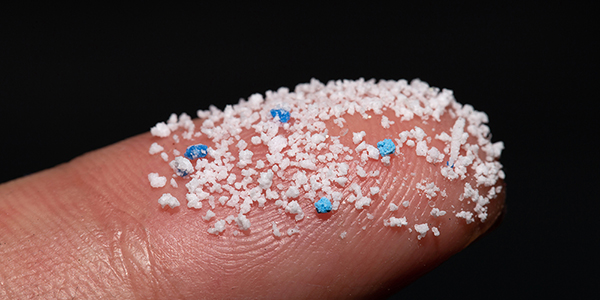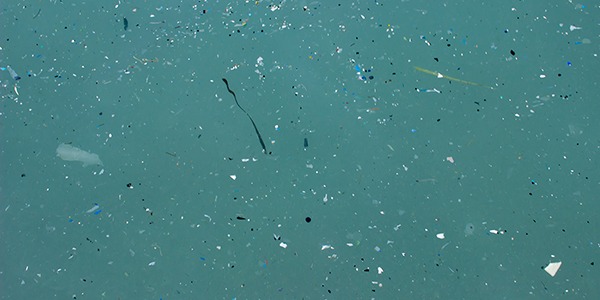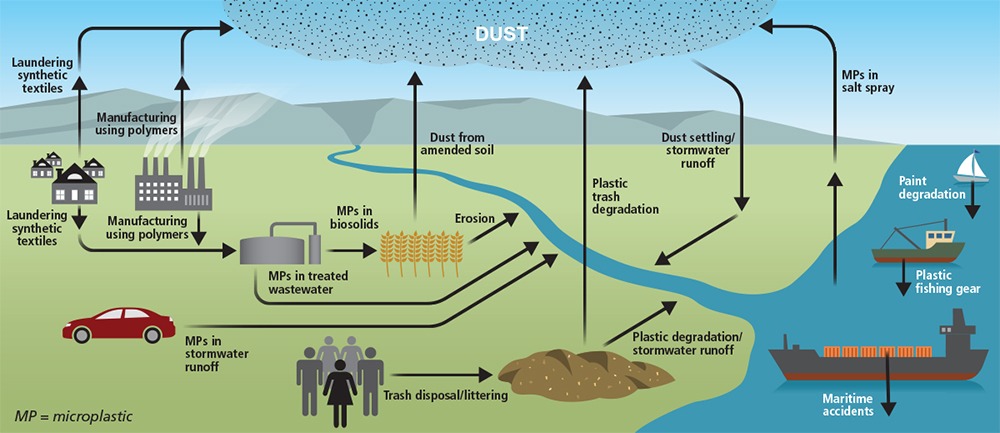Microplastics are emerging as a contaminant of interest globally, with particular focus on releases of microplastics to surface water (streams and rivers) and air. The State of California is implementing legislation for microplastics that took effect in 2021. There are regulations already in place in other countries, and other U.S. states will likely follow soon. Companies that could potentially be associated with introducing microplastics to the environment should prepare themselves for these regulatory changes. Affected industries include commercial launderers, wastewater treatment facilities, beverage manufacturers, the tire industry, and many others.
This first in a series of article on microplastics explores what microplastics are and why they are becoming a regulatory concern. In subsequent articles, we will explore why microplastics are gaining focus as an emerging contaminant by reviewing the health and environmental effects of microplastics, the increasing global awareness of microplastics, and methodologies that can be used to detect and treat microplastics.
What are microplastics?
Microplastics are broadly defined as polymer-based particles 5 millimeters (mm) (5,000 micrometers [µm]) or smaller. In addition to being classified by size, microplastics can be categorized according to type of polymer, additives used, color, size, shape, or whether the microplastic is derived from a primary or secondary source. Primary microplastics include feedstock for manufacturing plastic products, such as pellets or nurdles, microbeads, and industrial abrasives, that were manufactured to be in the 5 mm or smaller size range. Secondary microplastics are fragments and microfibers generated from the degradation of macroplastic items such as plastic bottles, shopping bags, or polyester clothing due to friction, UV exposure, oxidation, and other mechanisms. The state of California divides microplastics into four sub-groups based on particle size:
| Nanoplastics | Sub-micron plastics | Small microplastics | Large microplastics |
|---|---|---|---|
| 1-100 nm | 100-1,000 nm | 1-100 µm | 100-5,000 µm |
Note: 1 mm = 1,000 micrometers (µm) = 1,000,000 nanometers (nm)

Microplastics are a concern because they are persistent and ubiquitous in the environment, and recent research has connected microplastics with potential adverse effects on humans and aquatic life. They have been found in rivers and lakes all over the world and from the top of Mount Everest to the bottom of the deepest oceans. An estimated 31.9 million metric tons of plastic waste are released into the environment every year, and an estimated 15-40% of that mass ultimately reaches the world’s oceans.
Where do microplastics come from, where do they go, and why should you care?
Notable sources of microplastics include abrasion and wear of plastic coatings, laundering of synthetic textiles, generation of tire dust from automobile tires, decomposition of plastics through ultraviolet radiation, and plastic microbeads contained in consumer products and used in manufacturing. The degradation of polymer-based materials can release microplastic particles to the air as dust, or to stormwater through transport via surface runoff. Microplastics contained in consumer products or used in manufacturing can be discharged to wastewater treatment plants.
Wastewater treatment is effective at removing upwards of 95% of microplastic from the water stream through the sedimentation process as biosolids, with the remaining microplastics (primarily nanoparticles) discharged to the receiving water body. Biosolids, when not incinerated or landfilled, are used as fertilizer in landfarming, and studies have shown that plants can uptake microplastics from soil, which can in turn enter the food chain.
Microplastics in soil can also be released to air as dust. It has been estimated that 2% to 6% of particulate aerosols are comprised of microplastics. Microplastics that settle onto surfaces (e.g., from airborne dust and deposition from sources such as tire wear on road surfaces) are ultimately washed into stormwater. Studies suggest that stormwater runoff is the predominant source of microplastics to surface water, with one study suggesting that stormwater contributes more than 300 times as much microplastics content to surface water than wastewater from treatment plants.

Most stormwater and wastewater treated effluent ultimately flows to surface water. Rivers ultimately flow to the oceans. It has been estimated that 70% of the microplastics in oceans are from land sources that released microplastics to rivers. The remainder of microplastics in oceans are thought to be from maritime debris, including synthetic commercial fishing gear, maritime accidents, and trash.
In summary, microplastics are a potential concern for the degradation of surface water quality and air quality. The most significant transport pathways to surface water are via dust and stormwater runoff. The European Union has banned the addition of microplastics to consumer products, and Canada plans to ban single-use plastics in the near future. California’s legislation will require the state to begin building microplastics management strategies for both drinking water and California’s coastal ocean and estuaries. With the introduction of standardized testing protocols and evaluation criteria, the potential significance of microplastics in environmental media will become better understood, and this may in turn inform future regulatory actions by California and other states.
If your business manufactures, uses, or stores plastics, you may want to keep track of new microplastics regulations and legislation. Haley & Aldrich is monitoring technical and regulatory actions on microplastics, has team members on the Interstate Technology and Regulatory Council (ITRC) subcommittees on microplastics, and has the in-house expertise to help you understand your potential liabilities regarding microplastics and stormwater compliance. We are also monitoring conversations about microplastics in air, which may also be regulated in the future. Please reach out to any of the authors listed below if you have questions.
Published: 11/10/2021
- Industrial and manufacturing
- Automotive
- Consumer products
- Food and beverage
- Manufacturing
- Contaminated site management
- Emerging contaminants
- Water resources
- Stormwater
Authors

Principal Consultant, Risk Assessment

Technical Expert, Energy & Mining




